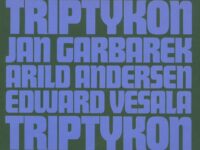Every time I listen to The Colours of Chloë I’m astounded that something so eloquently and elaborately conceived and performed could be someone’s first time out as a leader.
German bassist Eberhard Weber had already been on the jazz scene for over a decade when he recorded The Colours of Chloë in 1973, having served as a sideman to Stéphane Grappelli, Joe Pass and Hampton Hawes, and as a member of Wolfgang Dauner’s band for a number of years. But none of that gave away any indication of this stunning debut for ECM Records, deftly assimilating classical, jazz, folk and even world fusion into an impressionistic whole centered around his highly expressive standup electric five-string bass.
Weber successfully absorbed all these streams of music and synthesized them into his own characteristic. In doing so, he opened up what I regard as the mid-70s-early 80s golden era of ECM Records, which elegantly combined the formality and taste of Euro-centric music forms with the abandon and risk-taking of American jazz and improvised music. Almost all of it immaculately engineered under the supervision of label founder Manfred Eicher. More than just about anyone on the roster save for Keith Jarrett, Eberhard Weber’s sound became emblematic of that “ECM Sound,” and it started with The Colours of Chloë.
One of the ways that Weber accomplished all this was by using composition and arrangement as instruments onto themselves. “More Colours” is largely rendered by the cello section of the Südfunk Orchestra, making way after a lush introduction of poignant chords for Weber himself, who doesn’t so much solo as to tell a lonely, evocative tale as no other bassist can.
The return of the orchestration ends the track in the same key that “The Colours of Chloë” begins, suggesting as the song titles implies, that the two songs are movements of the same overall piece. Rainer Brüninghaus’ gurgling electric keyboard evokes a springtime emergence from a winter slumber. Weber’s ocarina – a flute-like instrument – plays a simple but memorable two-note theme, but the song soon takes the listener on a ride, moving through all these buoyant passages, notably Weber’s yawning bass playing lyrically, colorfully and sometimes with octaves. Brüninghaus delivers lovely and lively piano asides with the ample backing of Weber and drummer Ralf Hübner.
With the orchestra weaving in and out of view, the song traverses over chamber music, jazz and even rock, never feeling like a contrivance but rather almost a whole new genre that’s retained its freshness fifty years on. This track alone is a pinnacle moment in the storied history of ECM, and cast the template for not only Weber’s subsequent works but for a new generation of creative jazz artists who offered a satisfying alternative to the chops-heavy emphasis of fusion jazz throughout the 70s.
Even as these are instrumentals, Eberhard Weber showed early on how to utilize wordless vocals to accentuate the melody (something he would later explore to the fullest with Fluid Rustle). The opening and closing segments of “An Evening With Vincent Van Ritz” uses Gisela Schäuble’s voice in this manner alongside the celli, with a decidedly rock-jazz middle section featuring Ack van Rooyen’s flugelhorn and a muscular rhythm section of Weber with drummer Peter Giger in a moment of the album that shows its age, but also enjoyable to hear Weber chop it up in an electric quartet.
As an extended form composition, “No Motion Picture” is a side-long track on the original vinyl, running almost exactly as long as the prior three cuts combined. The opening motif is a shower of Brüninghaus’ keyboards forming layered ostinatos and anchored into place by Weber’s funky bass lines. It’s easy to not be cognizant of the strings weaved in, but if they didn’t exist, you’d certainly notice something missing. Another gorgeous, unaccompanied bass feature temporarily interrupts this groove. Throughout the sonic odyssey, the ensemble visits various interesting motifs while periodically touching base with the memorable theme. The variation between sections as the song maintains coherency makes those nineteen minutes fly by.
ECM Records has now made The Colours of Chloë available in 96kHz/24-bit Hi-Res format as part of a remastering campaign that includes twelve other albums from ECM’s analog era. Get The Colours of Chloë from HDTracks, ProStudioMasters and Qobuz.
- Marshall Allen’s Ghost Horizons – ‘Live In Philadelphia’ (2025) - May 19, 2025
- Satoko Fujii This Is It! – ‘Message’ (2025) - May 14, 2025
- Joshua Banks feat. Nick Lange , “Agila” from ‘Para Sayo’ (2025): Video premiere - May 12, 2025




